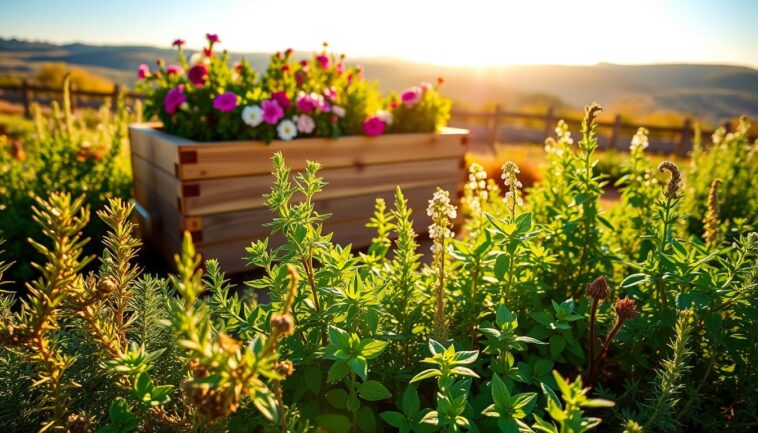I’m excited to share my experience with starting a spring herb garden. I hope you’ll join me on this journey. With 14 popular culinary herbs to choose from, creating a thriving herb garden can be a fun and rewarding experience. To get started, it’s essential to choose the right herb plants and provide them with proper care, following effective herb garden tips.
When selecting herb plants, I recommend avoiding big box hardware stores. They may have been treated with fungicides or synthetic fertilizers. Instead, consider buying from a local nursery or grower, or start your herbs from seed. This will give you a healthy foundation for your spring herb garden, and with the right care, you can enjoy a fragrant and thriving garden.
By following these herb garden tips and choosing the right plants, you’ll be well on your way to creating a beautiful and functional spring herb garden. With a little patience and practice, you can enjoy the many benefits of growing your own herbs. From fresh flavors to attractive foliage, you’ll make the most of your spring herb garden.
Why Spring is Perfect for Starting Your Herb Garden
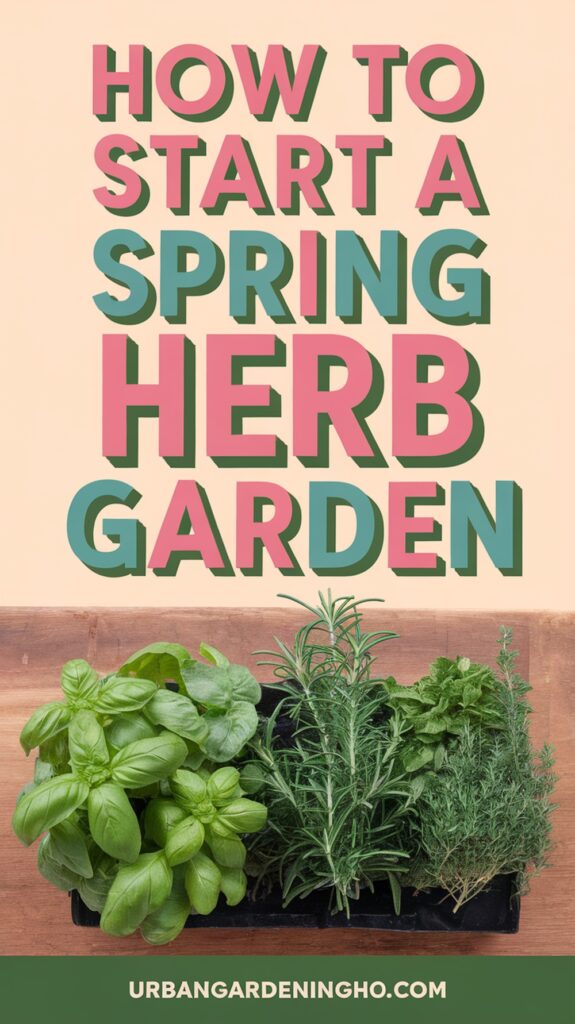
As the weather gets warmer, spring is the best time to start your herb garden. It has plenty of sunlight and mild temperatures. This makes it perfect for growing herbs.
Spring is great for outdoor activities and gardening projects, as spring garden ideas show. Here are some benefits of starting your herb garden in spring:
- Increased sunlight, which is essential for herb growth
- Mild temperatures, allowing for better establishment of plants
- A longer growing season, enabling you to enjoy your herbs for a more extended period
Starting your herb garden in spring lets you use the natural growth cycle of herbs. This makes caring for your plants easier and leads to a bigger harvest.
Essential Tools and Materials for Your Herb Garden
To start your herb garden, you’ll need some key tools and materials. A well-draining soil blend is vital for healthy herbs. It gives them the nutrients and drainage they need. You can make your own blend with topsoil, compost, and sand, or buy a pre-made mix.
For more tips on growing herbs, check out herb garden tips. They offer great advice on maintaining your herb garden.
Other important tools include containers or a garden bed, and a watering system. Make sure your containers have drainage holes to avoid waterlogged soil. You can use different materials like half wine barrels or hanging pots to make your garden look interesting.
Here are some key considerations for your herb garden:
- Choose a location with at least 4-5 hours of direct sunlight
- Use a well-draining soil blend to prevent waterlogged soil
- Water your herbs regularly, but avoid overwatering
By following these tips and using the right tools and materials, you can create a thriving herb garden. It will give you fresh, flavorful herbs all season long. Remember to keep up with herb garden maintenance to ensure your herbs keep growing and thriving.
Choosing the Perfect Location for Your Herbs
Choosing the right spot for your herbs is key in herb garden care. Herbs need lots of sunlight to grow well. Most herbs need at least six hours of direct sunlight every day.
Think about how much space you have. You can grow herbs indoors or outdoors. If space is tight, indoor growing with a light setup works. But, it can be expensive, and buying herbs might be cheaper in cold months.
Here are some important things to think about when picking a spot for your herbs:
- Sunlight needs: Most herbs need at least six hours of direct sunlight daily.
- Space matters: Decide if you’ll grow herbs indoors or outdoors, and pick a spot with enough room.
- Indoor vs outdoor: Weigh the pros and cons of indoor vs outdoor growing, like light setup costs and pests.
By thinking about these points, you can make a great spot for your herbs. This way, you’ll enjoy the benefits of herb garden care and growing herbs.
How to Start a Spring Herb Garden: Step-by-Step Guide
To start a spring herb garden, you need to prepare the soil and pick the right herbs. A good soil mix is key for your herbs’ health. You can make your own or buy one ready to go.
Next, choose whether to plant from seed or buy seedlings.
When planting, remember to space each herb correctly for them to grow well. Water them gently but well, and keep the soil moist during germination.
Soil Preparation
Soil preparation is a key step in starting a spring herb garden. Most herbs like well-draining soil. Too much water can harm them.
Planting Methods
You can start your herbs from seed or buy seedlings. If starting from seed, plant them in a seed tray or directly in the garden.
Spacing Guidelines
Proper spacing is vital for your herbs to grow well. Look up the specific spacing needs for each herb. By following these steps and tips, you’ll have a thriving spring herb garden. You’ll enjoy fresh, flavorful herbs all season long.
Best Container Options for Herb Growing
Choosing the right container is key for herb garden maintenance. I like using window boxes or large containers with good drainage. They create the perfect spot for my herbs to grow well.
For herb garden care, pick a container that’s big enough for the plant. It should also have good drainage to avoid soggy soil.
Popular choices for herb containers include half wine barrels, galvanized metal tubs, and wooden planters. These can hold multiple herbs, making your garden both beautiful and fragrant. Growing herbs like basil, rosemary, and thyme together in one container saves space and adds beauty.
Think about the size and growth habits of the herbs you want to grow. Mediterranean herbs like rosemary and thyme need well-draining soil and full sun. On the other hand, herbs like parsley and mint do well in partial shade. By picking the right container and caring for your herbs, you’ll have a constant supply of fresh herbs.
Here are some tips for growing herbs in containers:
- Choose a container with good drainage to prevent waterlogged soil
- Select a container that is large enough to hold the herb plant
- Use a well-draining potting mix and add perlite to reduce weight
- Water regularly, but avoid overwatering
- Fertilize regularly with a complete, organic fertilizer
Top Spring Herbs for Beginners
Spring is a great time to start growing herbs. Beginners should pick easy-to-grow herbs that do well in different conditions. Top choices include basil, mint, parsley, cilantro, thyme, and oregano. These herbs are easy to care for and add flavor to many dishes.
One big plus of growing herbs in spring is the longer growing season. With the right tips, you can have a steady supply of fresh herbs. For instance, basil can grow quite tall and wide, needing lots of sunlight. Mint spreads a lot, making it perfect for containers.
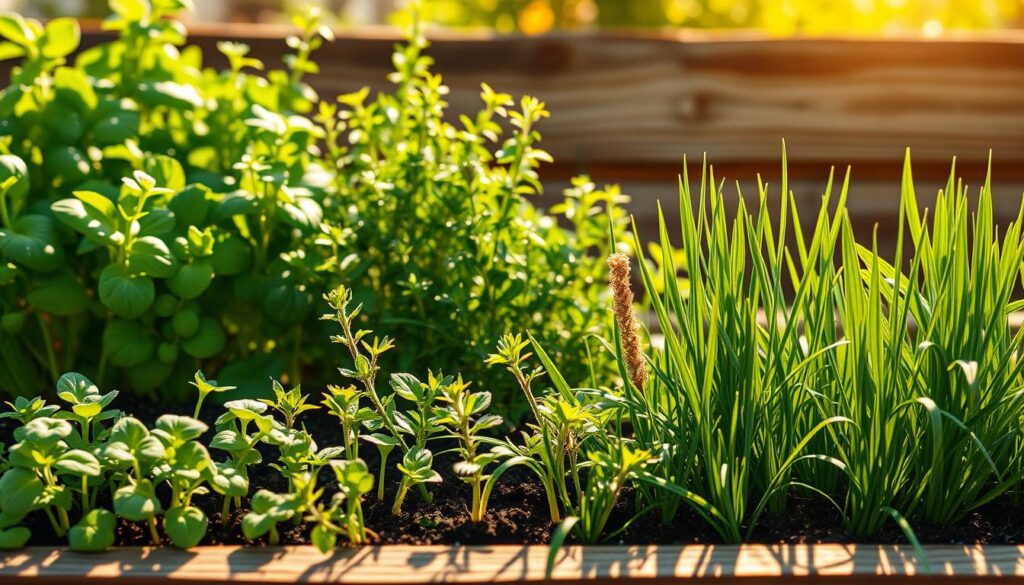
- Parsley, which can grow between 8-24 inches tall and wide
- Cilantro, which thrives in shaded areas and is known for producing coriander seeds
- Thyme, which can reach heights of up to 15 inches and requires 6-8 hours of direct sunlight
By following these tips and choosing the right herbs, you can have a thriving herb garden. It will give you fresh flavors all season. Whether you use containers or the ground, with practice, you’ll enjoy growing herbs soon.
Understanding Soil Requirements for Herbs
Herb garden care starts with knowing the soil needs. Most herbs love well-draining soil that’s full of nutrients. A great mix includes topsoil, compost, and sand, plus some extra nutrients for your herbs.
To keep your herb garden healthy, dig the top 6-8 inches of soil. This helps water soak in and roots grow. You can check if the soil is ready by doing a soil ball test. If it breaks easily, it’s ready. But if it stays in big chunks, it’s too wet.
Here are some tips for making a good soil blend:
- Use a mix of topsoil, compost, and sand
- Add compost to make the soil healthier
- Plant cover crops to stop soil erosion and make the soil better for next year
By following these tips, you can make a thriving herb garden. It will need little care. Just remember to update your soil and add compost often to keep your herbs happy and healthy.
| Soil Type | Characteristics | Herb Garden Care Tips |
|---|---|---|
| Well-draining soil | Rich in nutrients, good water penetration | Use a mix of topsoil, compost, and sand |
| Compacted soil | Poor water penetration, poor root growth | Work the top 6-8 inches of soil for better water and root growth |
Watering Techniques for Healthy Herbs
Watering is key in herb garden care. Herbs need the right amount of water to grow well. Check the soil moisture by sticking your finger into it. If it’s dry, it’s time to water.
Herb gardeners often water once or twice a week. But, this can change based on the herb, soil, and weather. For example, basil needs watering once a week in full sun. Mint, on the other hand, needs water every day.
Using a drip irrigation system or soaker hose helps. These systems water the roots directly, saving water and preventing runoff.
For more tips on watering herbs, check out this guide. It covers the best ways to keep your herb garden healthy. Some herbs, like rosemary and thyme, need less water. Others, like cilantro and dill, prefer consistent moisture.
Finding the right watering balance is vital for your herbs. Too much water can cause root rot, while too little can stress the plants. By understanding your herbs’ needs and using smart watering systems, you can have a lush and fragrant herb garden.
Natural Fertilizing Methods for Herbs
As I care for my herb garden, I’ve learned how vital fertilizing is. It’s key for their growth and taste. Natural methods like compost tea or worm castings are great. They slowly release nutrients.
These natural methods boost herbs’ health and taste. Compost tea, for instance, is made by soaking compost in water. It’s a safe way to feed your herbs without overdoing it.
Here are some tips for fertilizing herbs:
- Use compost tea or worm castings for a natural and slow release of nutrients
- Fertilize herbs regularly, but avoid over-fertilizing which can reduce essential oil concentration and flavor
- Container-grown herbs require more frequent fertilization due to quicker nutrient washout
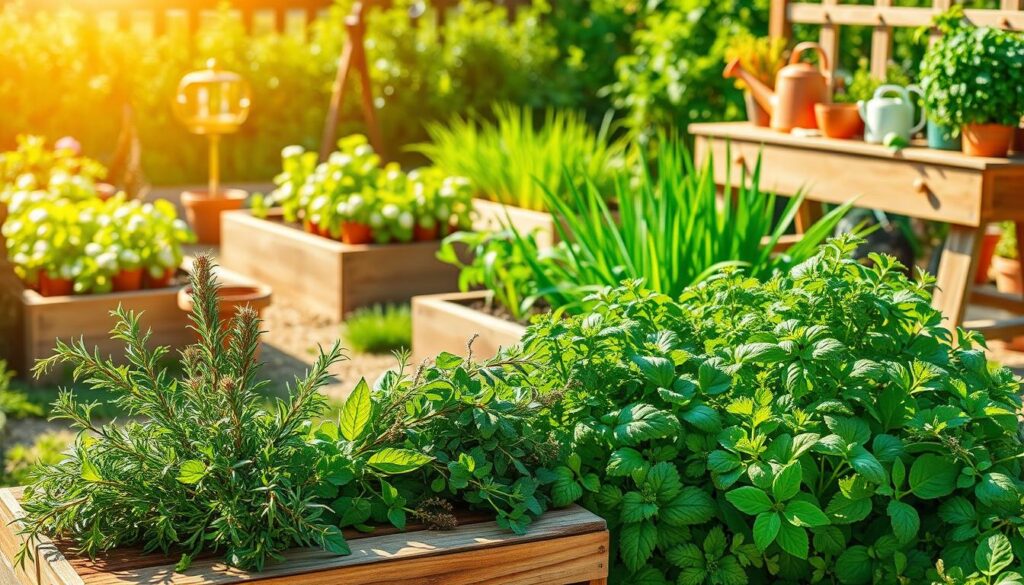
In conclusion, taking care of your herb garden means giving them the right nutrients. Natural fertilizers like compost tea or worm castings are perfect. Follow these tips to keep your herbs happy and healthy.
Common Spring Herb Garden Challenges
When I take care of my herb garden, I face several challenges. Pests, diseases, and weather damage can harm my plants. To deal with these, I use special care and growing techniques.
Pests like aphids, whiteflies, and spider mites can be a problem. I fight them with natural methods, like introducing beneficial insects or using neem oil. Diseases like root rot and powdery mildew can be stopped by ensuring good air flow and careful watering. Weather issues, like frost and heat, are managed with row covers or moving plants inside.
Pest Management Strategies
- Introduce beneficial insects, like ladybugs or lacewings, to control aphid populations
- Use neem oil to repel whiteflies and spider mites
- Inspect herbs regularly for signs of pests or diseases
By using these methods, my herb garden stays healthy and productive. Keeping an eye on my garden and taking care of it is key to avoiding common problems.
Disease Prevention and Weather Protection
To stop diseases and protect my herbs from weather, I take several steps. I ensure good air flow, water carefully, and use row covers for frost and heat protection. These actions help keep my garden safe from disease and weather damage.
| Common Herb Garden Challenges | Prevention and Management Strategies |
|---|---|
| Pests (aphids, whiteflies, spider mites) | Introduce beneficial insects, use neem oil, inspect herbs regularly |
| Diseases (root rot, powdery mildew) | Provide good air circulation, water carefully, use row covers |
| Weather damage (frost, extreme heat) | Use row covers, bring plants indoors, provide shade |
By following these tips, I keep my herb garden healthy and productive. Good care and growing techniques are vital for overcoming challenges and enjoying a great harvest.
Harvesting Your Spring Herbs
Harvesting is key to caring for your herb garden. To keep plants bushy and prevent flowering, use the right cutting techniques. Always take no more than 30% of the plant at once to help it grow.
For the best taste, pick stems and leaves when the plant is at its peak, just before it flowers. Cut stems a quarter inch above a pair of leaves to encourage growth. Harvest flowers when they’re fully grown but before they wilt.
After picking, store your herbs in a cool, dry spot or freeze or dry them. This keeps your herbs fresh and flavorful. By following these steps, you’ll enjoy your herbs all season and keep your garden healthy.
Here are more tips:
* Harvest herbs when they’re about 6 inches tall for the best flavor and yield
* Regular picking can lead to more herbs
* Keep herbs in the fridge for a short time or freeze them for later
Companion Planting in Your Herb Garden
Exploring herb garden care, I found out about companion planting. It’s about growing different herbs together to boost their growth and flavor. For example, basil keeps pests like whiteflies and mosquitoes away, making it great for tomatoes.
Companion planting is key in herb garden care. It helps plants grow better and reduces the need for harmful chemicals. Some herbs and veggies can even increase yields by up to 20%. Herbs like marjoram and tarragon work well with many vegetables, perfect for a diverse garden.
Here are some examples of herbs used in companion planting for growing herbs:
- Basil: repels whiteflies, mosquitoes, spider mites, and aphids
- Mint: deters white cabbage moths, aphids, and flea beetles
- Parsley: attracts beneficial insects like parasitic wasps, ladybugs, and damselflies
- Rosemary: deters cabbage moths, bean beetles, and carrot flies
By using companion planting, my herb garden becomes a balanced and thriving space. The right mix of herbs improves growth, flavor, and keeps pests away. This makes my garden a place for tasty and healthy herbs.
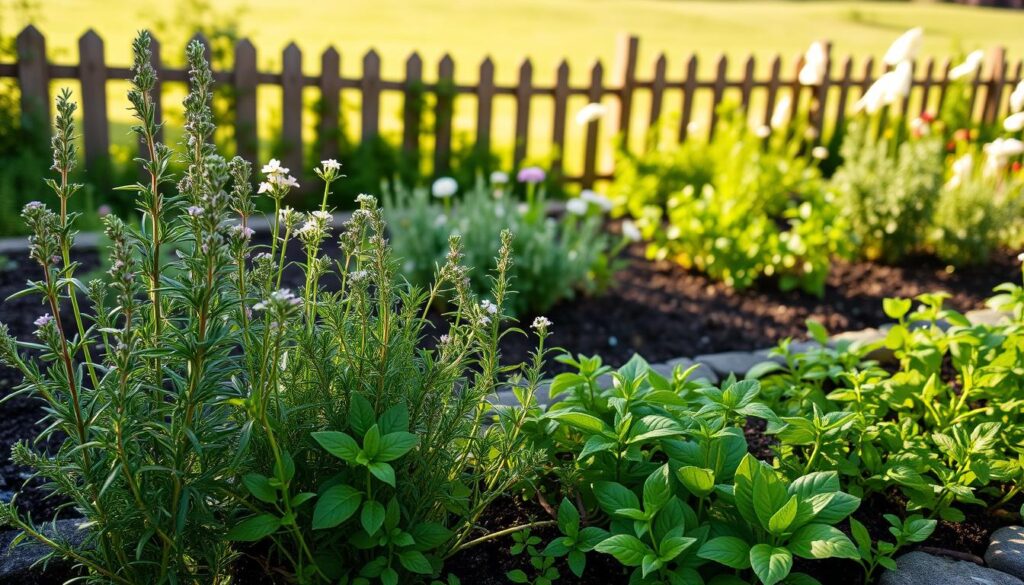
Expanding Your Herb Garden
As your herb garden grows, you might want to add more plants or share with loved ones. Keeping your garden healthy is key. You can make new plants from old ones through division or layering. This way, you can share your favorite herbs.
Succession planting is another great way to grow your garden. It means planting new herbs every few weeks for a steady harvest. This is good for annuals like parsley and basil, which need regular water to avoid bolting. With the right care, like watering and fertilizing, your herbs will stay healthy and strong.
- Plant herbs a hand’s width apart to prevent overcrowding
- Provide wind protection, such as a wall or fence, for outdoor herb growth
- Water herbs in the morning, not in the evening, to avoid root rot
By following these tips, you can make your herb garden a lush and diverse space. It will give you fresh flavors and fragrances all season.
Seasonal Maintenance Schedule
To keep your herb garden thriving, it’s key to have a seasonal maintenance plan. This plan should cover tasks like watering, fertilizing, and pruning. These steps ensure your herbs get the care they need all year.
When spring comes and the temperature stays above 50°F, clean up your garden. This is part of regular maintenance.
Some important tasks for your seasonal plan are:
- Watering: Young plants need consistent water, and deep watering helps roots grow strong.
- Fertilizing: A balanced, organic fertilizer gives your herbs the nutrients they need.
- Pruning: Regular pruning keeps your herbs in shape and promotes healthy growth.
By sticking to a seasonal maintenance schedule, you can have a thriving herb garden all year. Make sure to adjust your plan for your herbs’ specific needs and the changing seasons.
Conclusion: Growing Success with Your Spring Herb Garden
Starting your spring herb garden is exciting. With the right knowledge and care, you can grow a thriving garden. Choose the best herbs for your area and follow the steps in this guide.
By doing so, you’ll enjoy the many benefits of growing your own herbs. Don’t be afraid to try new things and enjoy the fresh flavors from your garden.
